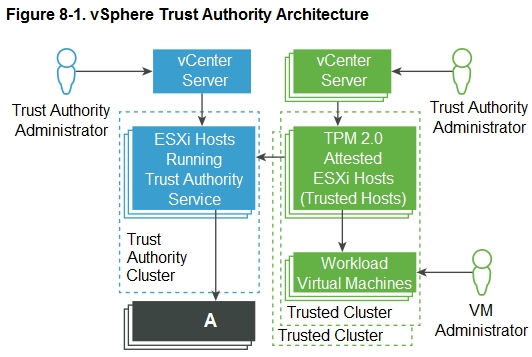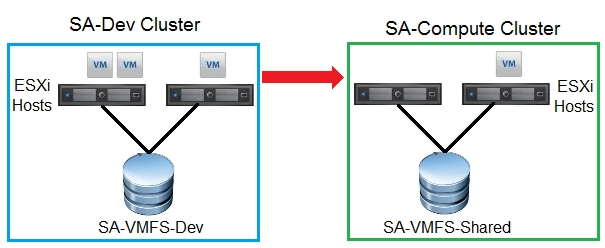Refer to the exhibit.
Which trusted infrastructure component is missing and represented by the area labeled `A`?
A
Reference:
https://docs.vmware.com/en/VMware-vSphere/7.0/com.vmware.vsphere.security.doc/GUID-CEFC9BAE-1685-49A7-9854-4AC997F2F1C3.html https://docs.vmware.com/en/VMware-vSphere/7.0/com.vmware.vsphere.security.doc/GUID-E4945A3B-BCBE-42AD-A00F-6A6957217041.html
What are two supported ESXi boot options? (Choose two.)
BD
An administrator receives an escalation to investigate a low disk space alarm on a datastore. The administrator discovers that a snapshot has been accidentally taken on a production, write-intensive database server. The snapshot has grown to nearly 1 TB in size in less than an hour and continues growing every second.
Which behavior should the administrator expect while deleting the snapshot?
B
Which two storage technologies can an administrator use to deploy the Virtual Machine File System (VMFS)? (Choose two.)
AE
Reference:
https://www.vmware.com/content/dam/digitalmarketing/vmware/en/pdf/techpaper/vmware-vmfs-tech-overview-white-paper.pdf
An administrator would like to make virtual machine templates and ISO images available to all vCenter Server instances in the data center.
Which feature should the administrator use to achieve this goal?
B
Reference:
https://docs.vmware.com/en/VMware-vSphere/7.0/com.vmware.vsphere.vm_admin.doc/GUID-254B2CE8-20A8-43F0-90E8-3F6776C2C896.html
Refer to the exhibit.
An administrator enables email notifications as shown in the attached alarm. However, notifications are NOT being sent.
Where must the mail server settings be configured to resolve this issue?
A
An administrator is troubleshooting a recent failure and finds the following error messages:
Which action has failed, thus resulting in these errors?
B
Reference:
https://kb.vmware.com/s/article/2090545
What are two functions of vSphere Lifecycle Manager? (Choose two.)
AB
An administrator runs third-party software in a virtual machine (VM). The third-party licensing agreement requires payment of a license fee for each host to which the VM migrates.
How can the administrator configure Distributed Resource Scheduler (DRS) to minimize licensing costs?
D
Refer to the exhibit.
Which two migration methods can an administrator use to move virtual machines from the SA-Dev cluster to the SA-Compute cluster? (Choose two.)
CE